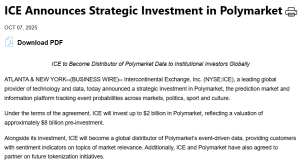Are we witnessing the end of Bitcoin’s legendary four-year cycle? Hunter Horsley, CEO of major spot Bitcoin ETF issuer Bitwise, just dropped a bombshell declaration that’s shaking the crypto world. The traditional Bitcoin cycle that investors have relied on for years might be officially over – and the implications are massive for your portfolio.
Why is the Bitcoin Cycle Changing Now?
Hunter Horsley made his groundbreaking announcement on social media platform X, explaining that market structure has undergone a fundamental transformation. The launch of spot Bitcoin ETFs combined with the new U.S. administration has created an entirely new playing field. The Bitcoin cycle we knew is being rewritten before our eyes.
According to Horsley, we’re now dealing with:
- Completely different market participants
- Changed trading motives and strategies
- Transformed liquidity mechanisms
- New regulatory environment
How Spot ETFs Revolutionized the Bitcoin Market
The introduction of spot Bitcoin ETFs marked a turning point for cryptocurrency markets. These financial instruments brought institutional capital and mainstream acceptance that simply didn’t exist during previous Bitcoin cycles. The traditional four-year pattern can’t account for this level of structural change.
Think about it: when billions of dollars flow through regulated ETFs rather than crypto exchanges, the entire market dynamic shifts. The Bitcoin cycle now responds to different signals and moves to a new rhythm entirely.
Is the Bear Market Really Ending?
Here’s the hopeful news: Horsley suggests the past six months have effectively been a bear market, and he believes we’re approaching the end. This perspective changes everything for investors who’ve been waiting for the traditional Bitcoin cycle to play out.
The key question becomes: if the old Bitcoin cycle is dead, what replaces it? We’re entering uncharted territory where:
- Institutional flows dominate price action
- ETF approvals create new demand channels
- Traditional market hours influence volatility
- Regulatory developments drive sentiment
What This Means for Your Bitcoin Strategy
If the Bitcoin cycle has truly transformed, investors need to adapt their approaches. The halving events and historical patterns that once guided decisions may no longer provide reliable signals. Understanding this new Bitcoin cycle requires watching different indicators.
Focus on these key factors instead:
- ETF flow data – Monitor daily inflows and outflows
- Institutional adoption – Watch for major corporate announcements
- Regulatory clarity – Follow policy developments closely
- Macroeconomic trends – Understand traditional market correlations
The Future Beyond the Traditional Bitcoin Cycle
We’re standing at a crossroads in cryptocurrency history. The Bitcoin cycle that defined the past decade is evolving into something new and potentially more stable. This doesn’t mean volatility disappears, but rather that the drivers of that volatility have changed fundamentally.
The maturation of Bitcoin markets through ETF adoption represents a coming-of-age story. The wild west days are giving way to institutional participation, and the Bitcoin cycle reflects this growing up process.
Conclusion: Embracing the New Bitcoin Reality
The message from Bitwise’s CEO is clear: adapt or get left behind. The traditional Bitcoin cycle served us well, but markets evolve. The combination of spot ETF approval and changing political landscapes has created a new paradigm that demands fresh thinking.
While the death of the four-year Bitcoin cycle might feel unsettling, it actually signals Bitcoin’s maturation into a legitimate asset class. The bear market’s potential end, coupled with these structural changes, could pave the way for sustainable growth that looks very different from anything we’ve seen before.
Frequently Asked Questions
What exactly is the traditional Bitcoin 4-year cycle?
The traditional Bitcoin cycle referred to predictable price patterns that occurred around Bitcoin’s halving events, which happen approximately every four years and reduce mining rewards.
Why are spot Bitcoin ETFs changing the market structure?
Spot ETFs introduced massive institutional capital, regulated trading vehicles, and mainstream accessibility that fundamentally altered how Bitcoin is bought, sold, and held.
Does this mean Bitcoin will no longer be volatile?
No, Bitcoin will likely remain volatile, but the sources and patterns of volatility are changing due to new market participants and mechanisms.
How should investors adjust their strategies?
Investors should focus more on ETF flow data, institutional adoption trends, and regulatory developments rather than purely historical price patterns.
Is this good or bad for Bitcoin long-term?
Most experts view this maturation as positive long-term, as it brings greater legitimacy, stability, and institutional participation to the cryptocurrency space.
Will halving events still matter?
Halving events will still reduce new Bitcoin supply, but their price impact may be different in the new market structure dominated by ETF flows.
Found this analysis helpful? Share this groundbreaking insight about the changing Bitcoin cycle with fellow investors on Twitter and LinkedIn. Help others understand why the old rules no longer apply and what the new Bitcoin reality means for everyone in crypto.
To learn more about the latest Bitcoin trends, explore our article on key developments shaping Bitcoin institutional adoption.
Disclaimer: The information provided is not trading advice, Bitcoinworld.co.in holds no liability for any investments made based on the information provided on this page. We strongly recommend independent research and/or consultation with a qualified professional before making any investment decisions.
Source: https://bitcoinworld.co.in/bitcoin-cycle-changes-etf-impact/


